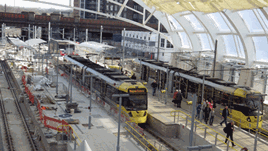Manchester has always been a dynamic and entrepreneurial city, as ambitious for its railways as for its varied industries, businesses and residents.
The city was at the vanguard of pre-Victorian railway development - the world’s first passenger service ran into Liverpool Road station on September 15 1830. Perhaps more indicative of what was to follow, this was also the world’s first inter-city railway, linking the ambitious Manchester with its age-old rival Liverpool. The latter’s wealth was based on maritime trade, a connection that Manchester’s merchants were keen to forge.
That Manchester city centre once boasted four major stations - London Road, Victoria, Exchange and Central, as well as lesser ones including Oxford Road, Deansgate, Mayfield and Salford Central - is a sign of the eagerness of competing Victorian entrepreneurs to bring to Manchester all the benefits of passenger and freight railways, from every point of the compass.
But by the early 1980s, railways in Britain had reached a major crossroads. Would they continue in slow (and probably terminal) decline, as roads became the ever more dominant mode of travel? Or would those who foresaw the inevitable congestion and environmental harm that this policy would cause set in motion a rail renaissance?
A report produced by Greater Manchester Council in April 1983 (Rail Strategy for Greater Manchester, The Options) examined two fundamental options.
Should Victoria station be closed (as Exchange and Central already had been), with all rail traffic concentrated at Piccadilly (formally London Road) and with a south-to-north ‘Picc Vic’ tunnel? Or should a light rail solution be developed to ease urban congestion?
In the end, and certainly to the relief of today’s transport planners, entrepreneurs and Mancunians in general, the latter option prevailed. Much of the 1983 report’s light rail option has evolved into the extremely successful Metrolink network, although while this now extends further than was proposed 32 years ago, some of the lines on the 1983 map have yet to see the benefits of modern trams.
Manchester Victoria survived the closure threat, although in the early 1990s the number of platforms was reduced from 14 to six. However, later this month the magnificent £44 million redevelopment of the station will be finished, with its eye-catching roof and greatly increased capacity for Metrolink services. And as the Northern Hub project is completed between now and 2019, so Victoria will become an even more important gateway to Greater Manchester.
Since 1983, several reports have suggested further developments to the Greater Manchester rail network, not least the 2003 RailPlan. While positive about the prospects, this was developed at a time when it was becoming clear to the city fathers that any ambition was problematic under the then franchising policy, especially given the lack of Government money for rail investment.
But now, with the launch on July 15 of the initial 12-week consultation phase of Transport for Greater Manchester’s Transport Strategy 2040: Our Vision, a whole new approach is being taken.
This strategy is not looking forward the conventional five years, but a huge 25 years. And this very long-term view is necessary, given the fundamental changes to the railway landscape and to the advances in technology in the past few years.
The Government is now very firmly committed to investing considerable sums each year in improving Britain’s railways, but recognises that the evaluation, planning and implementation of new schemes takes a very long time and cannot sensibly be accommodated within five-year horizons.
In addition, technology is being developed at such a pace that a long-term plan is necessary, so as to be flexible enough to cater for as yet unforeseen innovations.
After all, it’s only just 30 years since the first mobile phone appeared. And social media, which so dominates modern life, was a technological impossibility until relatively recently.















Login to comment
Comments
No comments have been made yet.